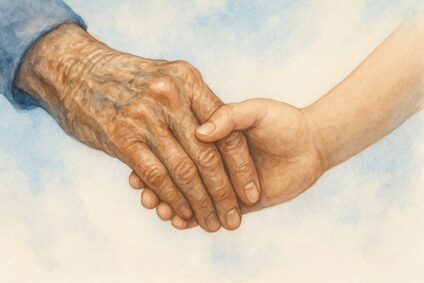Hope in the Ripples
When 150 people filled the hall at Hyde Park United Methodist Church this past March, the mood was not only energetic but unmistakably hopeful. They came to hear about affordable housing, immigration, LGBTQ rights, and the state of public education. Issues that too often divide us. But what emerged in that room was not division. It was “connection.” People leaned in, asked questions, and when the evening ended, their most common request was simple: do more of this.
That desire itself was a kind of hope. Not the thin hope of wishful thinking, but the sturdier kind that grows when people realize they are not alone. Stoics refer to this as sympatheia, the understanding that we are part of a larger whole. Marcus Aurelius described himself as a citizen of the world, tied by nature to every other human being. Hierocles used the image of circles, urging us to draw those outer rings of community, country, humanity, closer to ourselves. To live this way is to see hope not as a private possession but as a shared condition, strengthened whenever we come together.
I have seen this in my own work. Following the March event, we organized a follow-up training session called “Finding Your Voice.” Fifty-one people attended on a Monday night to learn how to write to their representatives, track legislation, and speak at public hearings. It would have been easier to stay home, but they came because something in them believed that one voice, joined with others, can matter. That belief is its own form of hope.
The ancients remind us that hope, like fear, can be dangerous if it pulls us too far into the future. But they also teach that when hope is rooted in action, it becomes a steadying force. James Stockdale survived a prison cell in Vietnam by holding to Epictetus’ reminder that character, not circumstance, is what we control. John Lewis called us to make “good trouble,” not because victory was assured, but because action itself was the measure of integrity. These were not people clinging to fantasy; they were people who found hope in fidelity to what they could do, day by day, together with others.
 Hands Across Time
Hands Across Time
That same lesson was etched in my own family. My mother worked as a school nurse for 36 years. She patched scraped knees and handed out bandages, yes, but she also noticed when a child came to school without lunch, when a pair of shoes was too small, when a student needed glasses just to keep up. She fought for those things, often quietly, always persistently. She never knew what became of most of those children. But I believe the ripples of her care carried forward. A child who could see the blackboard had a better chance to learn. A student who felt safe in the nurse’s office carried that sense of safety into adulthood.
One parent told her, after her child was in high school, that their son had once been written off as inattentive and disruptive. Mom had recognized something the teachers missed. That he couldn’t hear. With hearing aids, his grades went up, and he began to thrive. And near the end of her own life, one of Mom’s hospice nurses realized Mom had been her second-grade school nurse. The ripples had come full circle. That is hope made visible: the unseen future shaped by ordinary acts of care.
And even now, the ripples continue. Her DAR chapter recently received memorials in her name, and a scholarship fund at the local community college added $750 to support the training of future nurses. Those dollars will open doors she’ll never see, yet they carry her legacy forward.
It is the same with justice work. None of us controls whether a particular vote passes or fails, whether policy shifts in the way we wish. But we do control whether the circles of concern are drawn closer, whether a neighbor finds courage because we showed up beside them, whether someone in power hears a story that changes how they think. Hope does not mean believing we will win every fight. It means trusting that our actions matter beyond what we can see, that the ripples will outlast us.
Marcus Aurelius put it simply: “What injures the hive injures the bee.” The inverse is also true. What strengthens the hive strengthens us all. When we gather in a church hall to learn about affordable housing, when we march for inclusion, when we write letters to defend public schools, we are strengthening the hive. We are enlarging hope.
This kind of hope is not naïve. It knows that setbacks will come, that progress can be slow, and even painful. But it also knows that despair is a luxury we cannot afford. The real choice is between cynicism, which isolates, and connection, which sustains. The Stoics point us toward the latter, reminding us that even emperors and slaves belong to the same human family. My mother’s life testified to the same truth.
So, when I think about hope, I no longer imagine it as something fragile and easily broken. It is a current that runs through generations and communities, gaining strength wherever people act with courage and compassion. It runs through a nurse’s office in a public school. It runs through a church gathering on a Thursday night. It runs through every citizen who decides their voice is worth raising.
Sometimes, hope is all we have.
The call, then, is simple and urgent: participate. Do not wait for hope to arrive fully formed. Create it. Step into the circle. Lend your voice. Add your ripple. The work may not be finished in our lifetimes. But the fabric we strengthen together will hold those who come after us. That is what it means to be a citizen of the world, and that is what it means to live in hope.

Pingback:Deep Something | Stoic Practices: Role Models